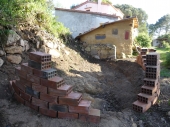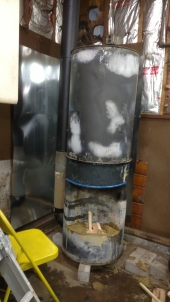Here are some pictures of the heater in the pole barn. a few specs:
8" flue
chimney is about 20' tall, black 8" stove pipe sits on an 8" elbow on floor of bell, then switches to 8" heating duct at about 8' (thinner gauge, galvanized), 12" heating duct starts at top of bell and sealed with cob to for a semi air tight insulating space like a double wall insulated chimney, total cost, around $200; temp at eye level is around 160F (uncomfortably warm to touch but doesn't burn)
T primer out of chimney for cold starts, works well;
bell is around 2.5'x 5'x3' tall, all single skin standard brick setting on 8'' blocks and perlite cob floor, top is bricks set on steel t posts, covered with screen and cob;
firebox is peter berg's 8" dimensions, standard firebrick except ceiling which is 1" ceramic fiberboard. I will redo this in the summer and make some refractory slabs to set on the ceiling to protect the soft fiberboard.
p channel is two 1.5" steel tubes with flaps on end to create turbulence;
riser is 4' tall, 8" diameter, octagon shape made of 1" ceramic fiberboard.
Almost no smoke if I start the fire right, takes about 5 minutes to rocket. The one picture of the chimney is steam on day 1. The single skin bell works great in my barn since it heats up faster and retains some heat to give off overnight but I would only need that to keep engines sortof warm on really cold nights.


Overall it's a real good heater. My thanks to Peter Berg and Matt Walker for sharing their work on the batch heaters!






